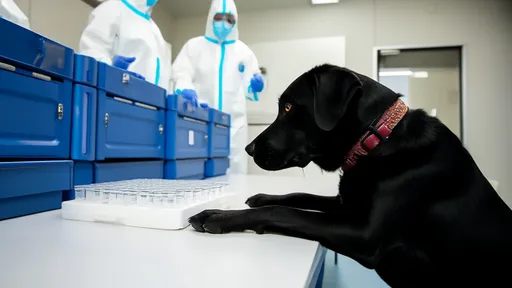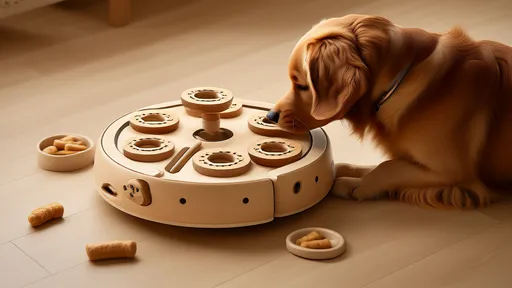The field of canine cognitive enrichment has seen remarkable advancements in recent years, particularly in the development of interactive toys designed for dogs suffering from dementia. As our understanding of canine cognitive dysfunction syndrome (CCDS) deepens, researchers and pet product innovators are collaborating to create tools that not only slow cognitive decline but also improve the quality of life for aging dogs.
The Growing Need for Canine Cognitive Support
With veterinary medicine extending dogs' lifespans, cognitive decline in senior dogs has become increasingly prevalent. Studies suggest that nearly 30% of dogs aged 11-12 years show signs of dementia, rising to 68% in dogs aged 15-16. This alarming statistic has spurred the pet care industry to develop solutions that go beyond traditional medications.
Dr. Emily Thornton, a veterinary neurologist at the Canine Aging Project, explains: "We're witnessing a paradigm shift in how we approach canine dementia. Where we once focused solely on pharmaceutical interventions, we now recognize the critical importance of daily cognitive stimulation through specially designed enrichment tools."
Breakthroughs in Interactive Toy Design
The latest generation of cognitive toys incorporates principles from human dementia care and canine psychology. Unlike standard puzzle feeders, these advanced toys adapt to a dog's changing abilities, providing appropriate challenges without causing frustration. Some models now include scent-based components, leveraging dogs' powerful olfactory systems to stimulate neural pathways.
One particularly innovative design comes from NeuroPaw, a startup founded by former veterinary researchers. Their flagship product features modular difficulty settings that caregivers can adjust as the dog's cognitive status changes. The toy uses a combination of tactile, auditory, and food rewards to engage multiple senses simultaneously.
Technology Integration Shows Promise
Perhaps the most exciting development involves the integration of smart technology into cognitive toys. Several companies are experimenting with toys that connect to mobile apps, allowing owners to track their dog's interaction patterns over time. These data points can provide early warnings of cognitive decline progression, enabling timely veterinary intervention.
However, researchers caution against over-reliance on technology. "The human-animal bond remains crucial," emphasizes animal behaviorist Dr. Marcus Wei. "These tools should complement, not replace, the daily interactions between dogs and their caregivers. The most effective protocols combine structured cognitive toys with positive social engagement."
Challenges in Product Development
Creating effective cognitive toys for dogs with dementia presents unique challenges. Designers must balance mental stimulation with safety considerations, as cognitive impairment often accompanies physical limitations. Products must be durable enough to withstand use by confused dogs, yet simple enough not to cause distress.
Material selection has emerged as a critical factor. Many manufacturers are moving toward FDA-compliant, non-toxic materials that can withstand repeated cleaning—an important consideration for incontinent dogs. The ideal texture appears to be slightly soft yet firm, providing comforting tactile feedback without being easily destructible.
The Science Behind the Benefits
Recent studies demonstrate measurable benefits from consistent cognitive toy use. Dogs engaging with these tools for just 20 minutes daily showed improved spatial memory in maze tests and reduced nighttime restlessness—a common symptom of canine dementia. MRI scans revealed increased activity in brain regions associated with problem-solving and memory.
Perhaps most importantly, caregivers report significant improvements in their dogs' overall demeanor. "It's not just about slowing decline," notes Dr. Thornton. "We're seeing dogs regain interest in their environment, showing more engagement with their families. That emotional component is priceless."
Future Directions in Canine Cognitive Care
As research continues, the next frontier involves personalized cognitive enrichment plans. Some companies are developing assessment tools to match individual dogs with appropriate toy types and difficulty levels. There's growing interest in combining physical exercise with cognitive challenges, recognizing the interconnected nature of physical and mental health in aging canines.
The field also shows promise for cross-species applications. Insights gained from canine cognitive studies may inform human dementia care, particularly in understanding how sensory stimulation affects neural plasticity. This reciprocal relationship between veterinary and human medicine could accelerate advancements in both fields.
For now, experts agree that early intervention remains key. Introducing cognitive enrichment before severe symptoms appear may help build neural reserves that delay dementia's progression. As awareness grows, these specialized toys are transitioning from niche products to mainstream recommendations in veterinary preventive care.

By /Jul 7, 2025

By /Jul 7, 2025

By /Jul 7, 2025

By /Jul 7, 2025

By /Jul 7, 2025

By /Jul 7, 2025

By /Jul 7, 2025

By /Jul 7, 2025

By /Jul 7, 2025

By /Jul 7, 2025

By /Jul 7, 2025

By /Jul 7, 2025

By /Jul 7, 2025

By /Jul 7, 2025

By /Jul 7, 2025

By /Jul 7, 2025

By /Jul 7, 2025

By /Jul 7, 2025